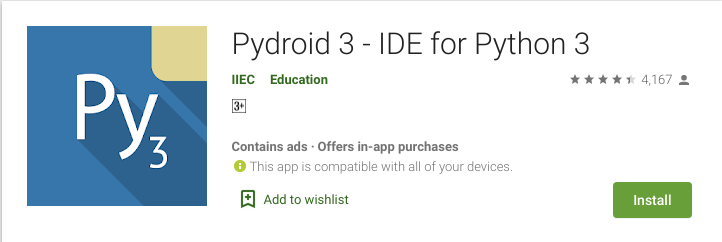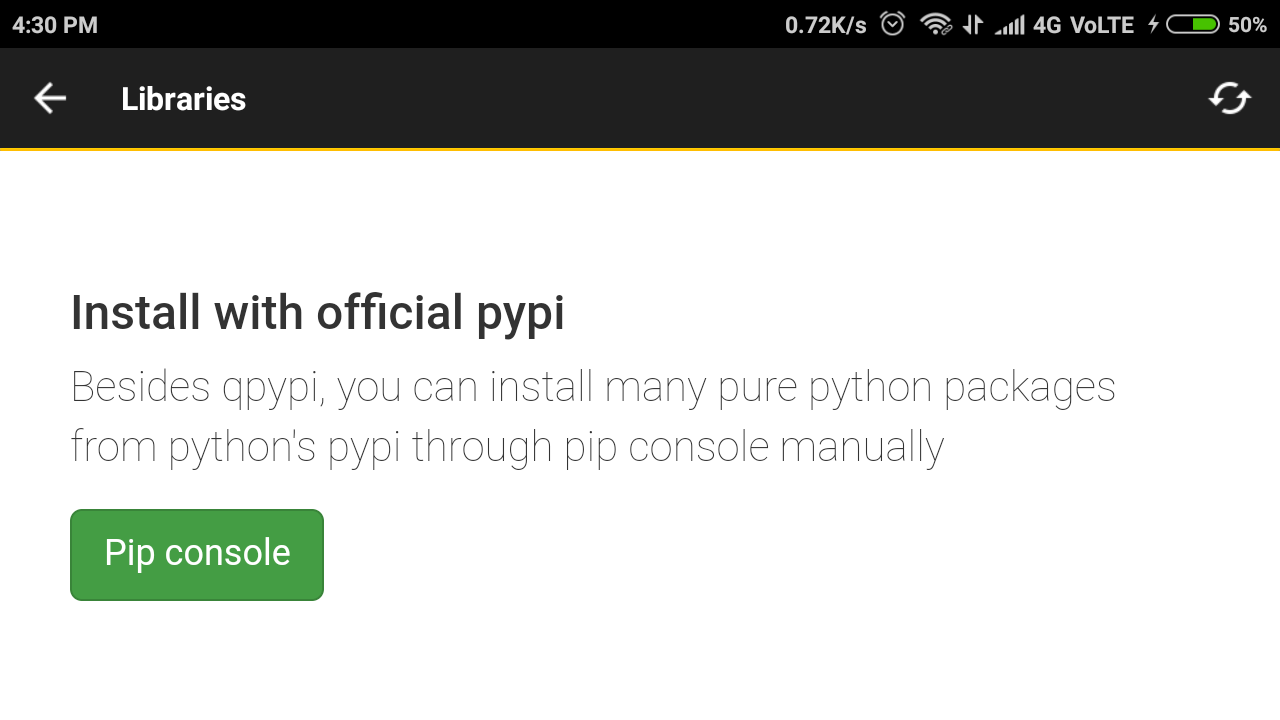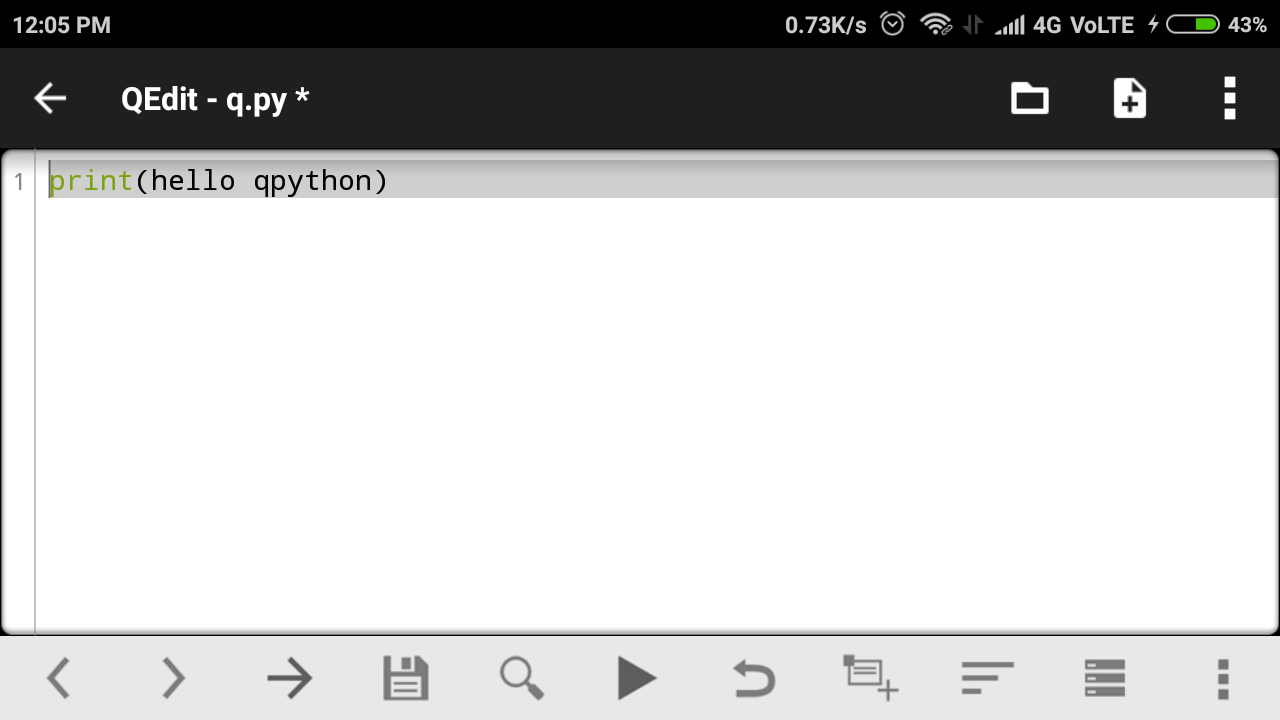This page gives details on accessing Android APIs and managing otherinteractions on Android.
- Python Code Runner For Android Free
- Python Code Runner For Android Version
- Python Code Runner For Android Software
Storage paths¶
If you want to store and retrieve data, you shouldn’t just save tothe current directory, and not hardcode /sdcard/ or some otherpath either - it might differ per device.
Instead, the android module which you can add to your –requirementsallows you to query the most commonly required paths:
app_storage_path() gives you Android’s so-called “internal storage”which is specific to your app and cannot seen by others or the user.It compares best to the AppData directory on Windows.
primary_external_storage_path() returns Android’s so-called“primary external storage”, often found at /sdcard/ and potentiallyaccessible to any other app.It compares best to the Documents directory on Windows.Requires Permission.WRITE_EXTERNAL_STORAGE to read and write to.
secondary_external_storage_path() returns Android’s so-called“secondary external storage”, often found at /storage/External_SD/.It compares best to an external disk plugged to a Desktop PC, and canafter a device restart become inaccessible if removed.Requires Permission.WRITE_EXTERNAL_STORAGE to read and write to.
Aug 26, 2020 Now install the Flask Python module using pip: (env) $ pip install flask Write Python code on Android. You're all set up. All you need now is to write the code for your app. To do this, you should have experience with a classic text editor. It runs on an interpreter system, that means the code can be easily run as soon as it is written. Python is a quick language. The syntax of Python is much easier than the syntax of any other language. Now you can easily learn Python through Certified Online Python Course. Android App with Python. Android applications are to be operated on the. Learn How to run python code in Android mobile. Best application will be give to you. Follow on Instagram for more update:- https://instagram.com/advertis. Download Python apk 3.2.1 for Android. Intelligent Python 3.6.9 IDE with syntax recognition, auto fill and much more.
Warning
Even if secondary_external_storage_path returns a paththe external sd card may still not be present.Only non-empty contents or a successful write indicate that it is.
Read more on all the different storage types and what to use them forin the Android documentation:
A note on permissions¶
Only the internal storage is always accessible with no additionalpermissions. For both primary and secondary external storage, you needto obtain Permission.WRITE_EXTERNAL_STORAGEand the user may deny it.Also, if you get it, both forms of external storage may only allowyour app to write to the common pre-existing folders like “Music”,“Documents”, and so on. (see the Android Docs linked above for details)
Runtime permissions¶
With API level >= 21, you will need to request runtime permissionsto access the SD card, the camera, and other things.

This can be done through the android module which is available per defaultunless you blacklist it. Use it in your app like this:
The available permissions are listed here:
Other common tasks¶
Dismissing the splash screen¶
With the SDL2 bootstrap, the app’s splash screen may be visiblelonger than necessary (with your app already being loaded) due to alimitation with the way we check if the app has properly started.In this case, the splash screen overlaps the app gui for a short time.
To dismiss the loading screen explicitly in your code, use the androidmodule:
You can call it e.g. using kivy.clock.Clock.schedule_once to run itin the first active frame of your app, or use the app build method.
Handling the back button¶
Android phones always have a back button, which users expect toperform an appropriate in-app function. If you do not handle it, Kivyapps will actually shut down and appear to have crashed.
In SDL2 bootstraps, the back button appears as the escape key (keycode27, codepoint 270). You can handle this key to perform actions when itis pressed.
For instance, in your App class in Kivy:
Pausing the App¶
When the user leaves an App, it is automatically paused by Android,although it gets a few seconds to store data etc. if necessary. Oncepaused, there is no guarantee that your app will run again.
With Kivy, add an on_pause method to your App class, which returns True:
With the webview bootstrap, pausing should work automatically.
Under SDL2, you can handle the appropriate events (see SDL_APP_WILLENTERBACKGROUND etc.).

Advanced Android API use¶
android for Android API access¶
As mentioned above, the android Python module provides a simplewrapper around many native Android APIS, and it is included by defaultunless you blacklist it.
The available functionality of this module is not separately documented.You can read the source onGithub.
Also please note you can replicate most functionality without it usingpyjnius. (see below)
Plyer - a more comprehensive API wrapper¶
Plyer provides a more thorough wrapper than android for a much largerarea of platform-specific APIs, supporting not only Android but alsoiOS and desktop operating systems.(Though plyer is a work in progress and not allplatforms support all Plyer calls yet)
Plyer does not support all APIs yet, but you can always use Pyjnius tocall anything that is currently missing.
You can include Plyer in your APKs by adding the Plyer recipe toyour build requirements, e.g. --requirements=plyer.
You should check the Plyer documentation for details of all supportedfacades (platform APIs), but as an example the following is how youwould achieve vibration as described in the Pyjnius section above:
This is obviously much less verbose than with Pyjnius!
Python Code Runner For Android Free
Pyjnius - raw lowlevel API access¶
Pyjnius lets you call the Android API directly from Python Pyjnius isworks by dynamically wrapping Java classes, so you don’t have to waitfor any particular feature to be pre-supported.
This is particularly useful when android and plyer don’t alreadyprovide a convenient access to the API, or you need more control.
You can include Pyjnius in your APKs by adding pyjnius to your buildrequirements, e.g. --requirements=flask,pyjnius. It isautomatically included in any APK containing Kivy, in which case youdon’t need to specify it manually.
Python Code Runner For Android Version
The basic mechanism of Pyjnius is the autoclass command, which wrapsa Java class. For instance, here is the code to vibrate your device:
Things to note here are:
- The class that must be wrapped depends on the bootstrap. This isbecause Pyjnius is using the bootstrap’s java source code to get areference to the current activity, which the bootstraps store in the
mActivitystatic variable. This difference isn’t alwaysimportant, but it’s important to know about. - The code closely follows the Java API - this is exactly the same setof function calls that you’d use to achieve the same thing from Javacode.
- This is quite verbose - it’s a lot of lines to achieve a simplevibration!

Python Code Runner For Android Software

These emphasise both the advantages and disadvantage of Pyjnius; youcan achieve just about any API call with it (though the syntax issometimes a little more involved, particularly if making Java classesfrom Python code), but it’s not Pythonic and it’s not short. These areproblems that Plyer, explained below, attempts to address.
You can check the Pyjnius documentation for further details.